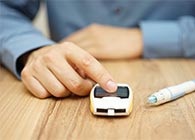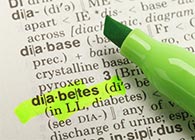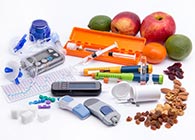Facts
Pre-conception
Pregnancy
Caesarean Section
Report – Diabetes in Pregnancy: Caring for baby after birth [2007]
Breastfeeding and Weaning
Gestational Diabetes

Gestational Diabetes
Gestational diabetes is the type of diabetes that occurs during pregnancy. Like other forms od diabetes, gestational diabetes affects the way the body uses the glucose [sugar] in the blood and as a result the blood sugars rise too high. The glucose in the blood is the body’s main source of energy.
If gestational diabetes is untreated or uncontrolled, it can result in a variety of health problems for both that mother and baby. So it is important that a treatment plan is worked out to keep blood sugars within the normal range. The good news is that controlling blood sugars can help to ensure a healthy pregnancy and a healthy baby.
Signs and Symptoms
Most women do not have any signs or symptoms of gestational diabetes but your healthcare professional will check for gestational diabetes as part of your prenatal care.
When signs and symptoms do occur they include:
- Excessive thirst
- Increased urination.
About 3 to 5% of all pregnant women develop gestational diabetes.
The Causes of Gestational Diabetes
Normal metabolism
Normally during digestion the body breaks down the carbohydrates you eat into simple sugars [glucose] and this glucose is absorbed into the blood and transported around the body by the blood vessel system to provide the energy needed for all our activities. This process cannot take place without insulin.
Insulin is produced in the pancreas, a gland behind the stomach, and helps the glucose to pass into the cells to provide energy and maintains normal levels of glucose in the blood.
The liver also plays a part in maintaining normal blood glucose levels. When there is more glucose in the cells than your body needs for energy, it is removed from the blood and stored it in the liver as glycogen. It can then be used when necessary, such as at times when you run low on glucose eg if you have missed a meal. In this situation the liver releases glucose into the bloodstream.
The amount of glucose in the blood varies according to several factors – the food eaten, exercise, stress and infections. The relationship between insulin, glucose and the liver makes sure that the blood glucose levels stay within normal limits. This should be 4 to 7mmols/l.
During pregnancy, the placenta, which supplies your baby with nutrients, produces hormones that prevent the insulin from working properly. These hormones include oestrogen, cortisol and human placental lactogen. They are vital for a healthy pregnancy but they also make the cells in your body more resistant to insulin.
As the placenta grows larger in the second and third trimesters, it produces even more of these hormones so further increasing insulin resistance. Normally the pancreas will respond by producing enough extra insulin to overcome this resistance. But sometimes three times as much insulin as normal may be necessary and the pancreas can’t produce enough. When this happens the glucose in the blood cannot be transported into the cells and too much remains in the blood so raising the blood glucose levels above normal and this is gestational diabetes.
Who is at Risk of Developing Gestational Diabetes?
Many women who develop gestational diabetes have no known risk factors and any woman can develop it although some are at greater risks than others. The risks increase with:
Age – Women older than 25 are more likely to develop it.
Family history – If a close family member, such as a parent or sibling, has Type 2 diabetes.
Personal history – If you’ve had it with a previous pregnancy or if you have had an unexplained still birth or a baby weighing more that 9 pounds, you may be screened more closely for gestational diabetes with the next pregnancy.
Weight – Being overweight before the pregnancy makes gestational diabetes more likely but gaining weight during the pregnancy does not cause it.
Race – Women from certain races are more prone to gestational diabetes.
Diagnosis and Screening
Until fairly recently there was no evidence from research that screening for gestational diabetes resulted in fewer childbirth complications and healthier babies but a study in 2005 showed that screening women and treating gestational diabetes aggressively resulted in fewer complications and healthier babies. So screening is usually a routine part of pre-natal care for most mothers. There is some debate amongst doctors about whether women under 25 with no risk factors for gestational diabetes should undergo the test because their risk is low.
Screening usually takes place between 24 and 28 weeks of the pregnancy because the condition can’t be detected until then, although if your doctor thinks that you are at patrticular risk, it may be done earlier.
What is the test?
You will be asked to drink a glucose solution that tastes very sweet and then you are asked to wait for an hour after which a blood sample is taken from a veitnin your arm. This will measure the level of sugar [glucose] in your blood and will tell how efficiently your body deals with sugar.
A blood sugar level of below 7.5mmols/l is usually considered normal in this test but having a blood sugar level above this does not necessarily mean that you have gestational diabetes although it does mean that you will need a further test. For the next test you will be asked to fast overnight, then you will be given another sweet drink with a higher concentration of glucose. This time your blood sugar levels will be monitored every hour for 3 hours and if at least two of these are abnormally high, this confirms the diagnosis of gestational diabetes.
During pregnancy routine urine tests are carried out but these are not sufficiently reliable to diagnose gestational diabetes because the amount of sugar in the urine can vary throughout the day as a result of the food eaten.
Treatment
Controlling your blood sugar is essential to having a healthy baby and avoiding complications during the delivery. Most women are able to do this with lifestyle changes – with diet and exercise, but some made need medication as well. In both cases measuring blood sugar levels is essential because it tells you whether your blood sugars are within the normal range.
Monitoring your blood sugar levels
This might sound difficult at first but once you have learnt how to do it, it is will become routine. You draw a drop of blood from your finger with a special device. This is placed on a test strip which is then put into a blood glucose monitor and this will give you your blood sugar level.
Blood sugar levels fluctuate throughout the day according to what you have eaten and how much exercise you have taken, so your doctor may suggest that you carry out blood sugar tests several times a day to ensure that they stay within healthy limits.
Note: your doctor will measure your blood sugars during labour – if they rise too high, your baby’s will also rise and this will cause the baby to produce insulin which may lead to low blood sugars [hypoglycaemia] after the birth.
Diet
A healthy diet is important for all pregnant women but for those with gestational diabetes, diet is part of the treatment – eating the right kind of food in the correct amounts is one of the best ways to control blood sugar levels.
Generally you should eat more fruit, vegetables and whole grains that are high in nutrition but low in fats and calories with fewer animal products and sweets. However, no one diet is suitable for everyone and you should discuss the diet that is suitable for you with a dietitian.
Exercise
Physical exercise generally lowers blood sugar levels for two reasons:
- It causes sugar [glucose] to be transported to the cells where it is needed for energy and so the blood sugar levels drop.
- It also reduces blood sugar levels by increasing body’s sensitivity to insulin – so your body needs less insulin to transport glucose to your cells.
Exercise is important for all pregnant women as it:
- Helps to prevent some of the discomforts during pregnancy – back pain, muscle cramps, constipation and sleep difficulties.
- It prepares you for labour by increasing muscle strength and the endurance developed by regular exercise reduces the stress on your ligaments and joints during delivery.
Type of exercise suitable for women with gestational diabetes
This should be discussed with your doctor or healthcare professional and then you can decide which activities you enjoy. Safe aerobic activities are a good way to lower blood sugars eg walking, cycling and swimming but ordinary activities such as gardening and housework can also have a similar effect. If you haven’t been active for some time, then you should build up your exercise levels gradually until you are carrying out moderate aerobic exercise on most days.
Stretching and strength training exercises combined with aerobic exercise at the same time everyday is the best combination. Varying your exercise routine and working out with other pregnant women can help you stay motivated.
Medications
Sometimes exercise and diet do not lower your blood sugar levels sufficiently and so medication may be necessary. For many years insulin was the only option for women with gestational diabetes because it does not cross over to the baby through the placenta but more recently the oral drug metformin [glyburide] is used.
Monitoring your Baby
Ultrasound
When you have gestational diabetes your baby’s growth will be closely monitored by ultrasound. Ultrasound uses high-frequency sound waves and computer processing to give pictures of your baby inside the uterus. Ultrasound is less accurate as your baby gets bigger.
Non-stress test or biophysical profile
If you are taking medications for your gestational diabetes your doctor may suggest a non-stress test [NST] or biophysical profile to make sure that your baby is getting enough oxygen and nourishment, especially nearer to the due date. This is a non-invasive test and causes does not cause your baby any stress. It takes about 30 minutes, does not require hospitalisation and is a simple test that checks how often your baby moves and how much the baby’s heart rate increases with this movement.
Length of pregnancy
In most cases doctors try to prevent your pregnancy from going longer than 40 weeks because this may increase the risk of complications. Most women with gestational diabetes deliver healthy babies, labour is not routine and delivery by Caesarian section is necessary in some cases. Gestational diabetes does not affect your ability to breast feed or look after your new baby.
Complications
If you have gestational diabetes, it is understandable that you may worry about the health of your baby and the possibility that it may cause birth defects. However, this is not usually the case because in general birth defects develop during the first 3 months of pregnancy and gestational diabetes does not develop until the second or third trimester so blood sugar levels are normal during the early, critical months. Most women go on to deliver healthy babies, but untreated or uncontrolled blood sugar levels can cause problems for you and your baby.
Complications that may affect your baby
Consistently keeping your blood sugar levels within the normal range can reduce these possible complications.
- Macrosomia is when the baby grows too large because extra glucose crosses the placenta into the baby’s blood. The baby’s pancreas then makes extra insulin to cope with this and the baby grows too large [macrosomia]. Very large babies may have difficulty during delivery and are more likely to sustain birth injuries or be born by Caesarian section.
- Hypoglycaemia [low blood sugar levels] occurs in some babies immediately after birth. This is because the babies are accustomed to receiving large amounts of blood sugar from their mothers and their own insulin production is high. Babies with hypoglycaemia have their blood sugar levels checked regularly after birth through an intravenous drip to prevent the blood sugars dropping too low.
- Respiratory distress syndrome is a condition which makes breathing difficult for the baby. It is more likely to occur in premature babies. It is caused by a lack of certain substances in the lungs that help to prevent the lungs from collapsing when the baby takes a breath. Some babies may need help with their breathing until their lungs become stronger.
- Jaundice is a yellowish colouring of the skin and the whites of the eyes. It occurs because the baby’s liver is not sufficiently mature. New born jaundice may begin within 2 or 3 days after birth but sometimes it does not appear for a week. New born jaundice is not a disease in itself and is not serious but will be monitored by the doctor.
- Shoulder dystocia can occur if the baby is very large and the shoulders are too big to move through the birth canal. In most cases doctors can free the baby but injuries may occur. This is a rare but serious complication of gestational diabetes.
- Stillbirth or death is a rare occurrence and if it occurs it is usually because gestational diabetes is undetected and therefore untreated.
Complications that may affect you
If you have gestational diabetes, then you may be at risk of the following complications:
- Pre-eclampsia is characterised by significant increase in blood pressure and left untreated, it can lead to serious complications for mother and baby, even death. Having gestational diabetes increases the risk of pre-eclampsia.
- Caesarian section may be recommended if your baby is large [macrosomia] but gestational diabetes itself does not mean that a Caesarian section has to be planned.
- Type 2 diabetes is more likely to develop in later life in women who have gestational diabetes, although many cases can be prevented with a healthy lifestyle of a health diet and regular exercise. Up to 40% of women develop Type 2 diabetes within 5 to 10 years after delivery and this risk may be increased in obese women.
Living with Gestational Diabetes
It is not easy living with a condition that can affect the health of your unborn baby and you may find it stressful, especially as you have to carry out regular blood sugar monitoring, follow a healthy diet and take regular exercise.
Prolonged stress itself can raise blood sugar levels and so it is important to learn as much as you can about your condition – books from the library, talking to other women with the same condition and of course, talking to your doctor, a dietitian, your midwife and a diabetes specialist nurse. They can answer your questions and help you to learn how to manage your blood sugar levels during pregnancy.
After your Baby is Born
You can breast feed and look after your baby. After the birth your blood sugar levels will be checked frequently and then again in 6 weeks. Gestational diabetes usually clears up after the baby is born because when the placenta is removed, the hormones it was producing, which caused your insulin resistance, are also removed.
Once you have had gestational diabetes it is sensible to have your blood sugars tested at least once a year and also to maintain a healthy lifestyle to lessen your chances of developing Type 2 diabetes later in life.

For more information on gestational diabetes, please visit the NHS Choices website:
NHS Choices: gestational diabetes
![]()



































